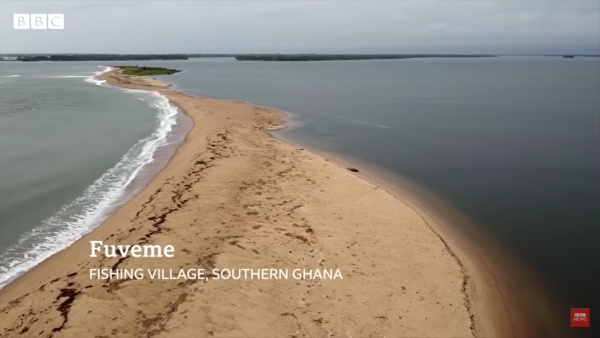VIDEO: Why these coastal villages in Ghana are sinking
The authorities are now facing the challenge of finding sustainable solutions to protect these vulnerable coastal communities, including coastal protection initiatives and community-based adaptation strategies.
The increasing vulnerability of these villages due to the rising sea levels and recurring tidal waves threatens the existence of these coastal villages and their people. Climate change, global warming, and other human activities can largely be blamed for this phenomenon of sinking, as it has become a significant threat to lives and properties in these coastal areas.
The sea provides employment to nearly 200,000 people and provides livelihood to millions. Most of the people who live in these areas resort to fishing and its related activities for survival. With the sea now drawing closer to these villages, the people are forced to move further into the hinterlands.
In April 2022, a tidal wave hit one of the coastal communities, Keta, causing significant damage. Pictures and videos that emerged showed homes inundated with seawater in places like Agavedzi in the Ketu South Municipality of the Volta Region, as well as Aklabanya in the Ada West District of the Greater Accra Region.
Local residents in these areas have witnessed the encroachment of the sea on their communities, leading to the loss of homes, arable land, and vital infrastructure. The impact is not only environmental but also has significant socio-economic implications for the affected populations.
Being an annual occurrence, many of these coastal communities are gradually being swept away by the sea little by little.
The specific factors contributing to the sinking of these Ghanaian villages are more complex and multifaceted.
This information is made available by the BBC.
Several coastal communities in the Volta region of Ghana, including Fuveme and Agorkedzi, are grappling with severe consequences as the sea levels continue to rise, engulfing homes, and land, and affecting residents’ livelihoods.
A resident from Fuveme, one of the affected villages, shared the devastating impact on the community, stating, “Here is Fuveme. See? We’re now in the middle of the sea. Here is the place where we lived before the sea took the land away. “I had my own house, a 12-bedroom house taken away by the sea. You see the tidal waves of the sea; nobody can stay here.”
The situation is dire for many residents who have lost their homes to the encroaching sea. Another resident expressed the helplessness of the community, saying, “When the tidal waves flooded our homes, we watched helplessly and tried to salvage some of our items. For now, we are managing because we don’t have money to build a concrete house. So, we are in God’s hands.”
Economic activities in these coastal communities have also been severely impacted. The changing coastline has altered the once-productive fishing grounds, affecting the livelihoods of the residents.
A local resident lamented, “At first, the sea was far away from us, and we used to get a lot of fish. Now, this place has become sandy. We don’t get a bumper harvest like we did before. All the women’s earnings here depend on the sea. But because of the rising tides, the money we’re able to earn has gone down.”
The District Chief Executive (DCE) of Anloga, Seth Yormewu, highlighted the urgency of the situation, stating, “When you check the history, the impact was not great like this. If nothing is done now, the whole community will be gone.”
The authorities are now facing the challenge of finding sustainable solutions to protect these vulnerable coastal communities, including coastal protection initiatives and community-based adaptation strategies.


